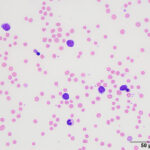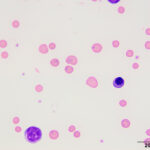Blood from a Holstein cow
Case Information
A 9 year old Holstein dairy cow that was in 7 months of gestation was presented to the Cornell University Equine and Farm Animal Hospital Large Animal Medicine Service for evaluation of an acute onset of anemia. The cow had a ten day history of mild diarrhea and inappetence and had been taken off the milking rotation about two weeks prior to presentation. There was a recent travel history from Maryland in the previous 3-4 months. On physical examination, the cow was weak with muscle fasciculations, severely dehydrated (skin tent, sunken eyes, cold extremities), and had a body condition score of 3/5. Rectal temperature was normal (100.6 F), as was the respiratory rate (32 breaths/minute), but the cow was tachycardic (120 beats/minute). Mucous membranes were pale and icteric. On abdominal auscultation, there were decreased gastrointestinal sounds and weak rumen contractions. A point-of-care blood gas analysis revealed an acidemia due to a metabolic acidosis (low bicarbonate and base excess concentrations) with a compensatory respiratory alkalosis (low pCO2 concentration). The L-lactate concentration was high (13.7 mmol/L, reference interval, 0.6-2.2 mmol/L).
Blood was taken after admission for a large animal hemogram plus fibrinogen (EDTA tube) and biochemical panel (heparin tube). Results are shown below along with images of the blood smear. After examining the results, answer the questions below.
- What is the mechanism of the anemia in the cow?
- Can you identify a cause for the anemia in the cow?
- How do you explain the lymphocytosis and what additional tests could you consider?
| Hemogram results |
 |
| Biochemistry panel results (heparinized plasma) |
 |
Answers on next page



